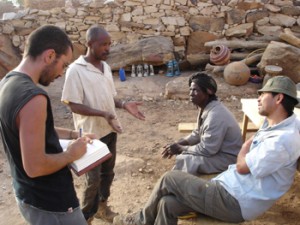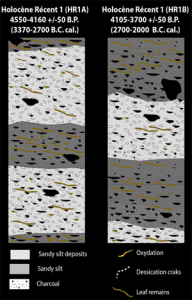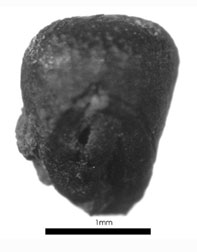
The right bank of the Yamé. On the left, the Varves site. Photo Y. Le Drezen
General objectives
The objective of archaeobotanical research on the Dogon plateau is the reconstruction of Holocene vegetation and landscape dynamics, focusing on climatic change and human-environment interrelations.
Key questions:
- What were the environmental conditions favouring Early Holocene ceramic production?
- How were flora and vegetation affected by anthropogenic fires and, yet so far unproved, animal husbandry at the Mid- to Late Holocene transition?
- How were they influenced by early pearl millet cultivation during the 2nd millennium BC and agricultural intensification with regular burning?
- How and when did the presently prevailing Faidherbia albida, agroforestry parklands establish?
- What were the ecological consequences of wood exploitation for iron metallurgy and ceramic production in the more recent periods, especially during the last millennium?
Sources of archaeobotanical information
The Holocene fluvial and marshy sediments of Ounjougou, formed by the Yamé river and its tributaries, are uniquely rich in botanical remains, embedded in stratified and well-dated layers. Due to the geographical position at the current boundary between the Sudanian and Sahelian zone, climate and vegetation shifts can be easily traced in the archaeobotanical assemblages. Generally, the river vegetation of the Yamé is over-represented, and the last few centuries are not well reflected in the deposits. Complementary to the off-site investigations at Ounjougou, on-site studies, mainly on macro-remains originating from archaeological sites (e.g. iron metallurgy sites, settlement mounds) are conducted. They can fill “time gaps” in the Ounjougou sequence and are likely to represent the whole diversity of vegetation types on the Dogon plateau.
Previous and current approaches of archaeobotanical research
While previous results of archaeological and palaeoenvironmental investigations at Ounjougou allowed for the definition of five major Holocene phases of landscape evolution, involving a first sketch of vegetation change and climatic oscillations, current palaeobiological research in close co-operation with chronostratigraphical, and geoarchaeological studies aims at a high-resolution sequence for the Yamé valley and the Dogon country. Besides this establishment of a finer time-scale, we intend to ascertain a clearer discrimination of natural and anthropogenic factors triggering landscape changes. A multiple approach is applied, comprising analyses of botanical macro-remains (wood charcoal, grass stems, seeds and fruits) and micro-remains (pollen, phytoliths, diatoms, and micro-charcoal revealing the signature of burning events), all originating from the same sediment samples. Archaeobotanical results can be directly correlated with sedimentological and micromorphological analyses which in turn reflect environmental fluctuations.
An outline of Holocene vegetation development on the Dogon plateau
Under the influence of climatic change and human impact, in particular bush fire and farming, the savannas around Ounjougou have distinctly changed during the last 12.000 years:
Early Holocene
10th-9th millennium BC (HA2-HA3), site Ravin de la Mouche:
Open Sahelian grassland prevailed; gallery forests with Syzygium and few Sudano-Sahelian species occurred along rivers. Fire activity was low.
8th millennium BC (HA4), site Ravin du Hibou:
Sudano-Guinean savannas established under the influence of high precipitation and regular bush fires.
Mid-Holocene
6th -5th millennium BC (HM2 & HM4), sites Ravin du Hibou, Balanites, Vitex and Detarium
African bamboo is dominant in the charcoal assemblages. It was growing locally near ponds and water courses, together withUapaca and Syzygium. Savannas and woodlands were mainly characterised by Sapotaceae (shea butter trees, Detarium, Prosopis and Terminalia.
Mid-Holocene/Late Holocene transition
44th millennium BC (HR1A), site Termitière:
The gallery forest still favoured southern elements (Syzygium and Uapaca). A mosaic of savannas alternating with woodlands and local dry forests occurred on well-drained soils, with several Sudano-Guinean trees (Lophira, Parinari), today absent from the area. Bush fires were frequent due to abundant biomass. A possible anthropogenic origin is still to be proved.
Late Holocene
3rd millennium BC, (HR1B), site Ravin Sud:
Vegetation changes indicate gradual aridification. Sudano-Guinean taxa became rare in savannas and woodlands and only persisted in gallery forests. Trees able to withstand fire and to sprout from suckers were supported by fire and clearing activities.
2nd and 1st millennium BC (HR2A,HR2B, HR2C), sites Varves and Rônier
Early pearl millet cultivation during the 2nd millennium BC is confirmed by direct dating of charred grains. Fires occurred annually (early as well as late in the dry season), most probably due to intended burning. Micromorphology attests strong seasonality and less precipitation. But climate was still more humid, indicated by the persistence of several species which are absent today. Sahelo-Sudanian taxa increased distinctly; pollen data indicate the establishment of Parkia-Vitellaria parklands. The species composition of the gallery forest initially remained unchanged, but a gradual retreat of southern elements took place in the course of this period.
Terminal Holocene
2nd millennium AD (HT4, HT 5, HT6), sites Ravin Sud, Unio and iron metallurgy sites:
Some distinct vegetation changes only happened during the last few centuries. Taxa with high regenerative capacity, like Combretum glutinosum, are currently very frequent on the Dogon plateau. In addition to agricultural intensification, exploitation of trees with high burning quality for iron metallurgy is one factor causing those recent changes. Today fires are absent from the Dogon Plateau. Burning events’ signature indicates they vanished towards the 15th-16th centuries. Faidherbia albida parklands probably established lately, as they are not reflected in the archaeobotanical data.
Barbara Eichhorn, Katharina Neumann, Yann Le Drezen, Aziz Ballouche, Laurent Lespez, Ahmed Fahmy



